ReaperCon is at the end of October this year, which means its only 5 months away, literally tomorrow by my ever slowing painting speed. One of my problems with painting competitions, in general, is that I really prefer the diorama category which means that there is a lot more work to be done on each entry. I'm contemplating just two entries this year. The first will be one of the Round 2 Eagles (the 12" versions not the big 22" monster) and a single vignette. The vignette will be no more than 3 minis on a very small base. I'm hoping to actually use a variation of the basing concept that I developed last year but wasn't able to actually put into play.
Last year my dioramas did quite well with the "Steady Lads" receiving a gold medal and "Shopping II" receiving the Best Hasslefree Miniatures award.
 |
|
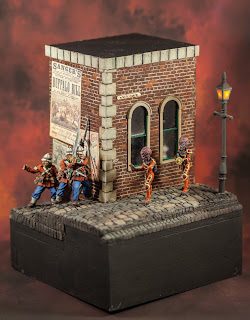 |
| There are a couple of easter eggs on this one that very few people picked up on. There is a rat coming out of rat hole in the building's side behind one of the soldiers and a resident in the far right hand window. |
 |
| Shopping II - Best Hasslefree Entry |
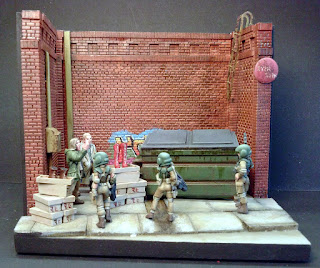 |
| My only regret on this one is not going a lot heavier with the graffiti. Quite frankly I wasn't sure I could pull it off so I kept it small, and then managed to hide most of it behind the dumpster. |
I really enjoy all the dioramas that show up at ReaperCon and other conventions. The diorama category was well represented at ReaperCon last year with about 40 entries most of which were excellent. However, there is always room for improvement! I usually try to make sure that my team gets to judge the diorama category at ReaperCon and I thought I would share what we are looking for in a diorama or vignette. These are my opinions in the end if you are happy with what you created that's what is really important
What is the difference between a diorama and a vignette? I have never really found a good definition but it seems that most vignettes are 3 or fewer figures on a smaller base, dioramas are anything larger than that. That seems pretty straightforward enough and within most competitions they are going to fall into the same category anyway. I feel like the vignette is harder to pull off effectively there are fewer elements so you need to be more precise with your story.
First; the Story. Seriously this really is the key to a successfully entry. You must clearly tell your story with just the miniatures and the scene you set them in. If you have to stand there and explain it to the people that are viewing it then you have failed. Simple stories are the best but a complex story or action can also be told. There is a tendency here to add as many miniatures as possible to tell our story and if there are to many miniatures the story can be lost. Unfortunately there is no formula for this you have to make that decision on your own.
Second; the Setting. There are two main pieces to setting; time and place. Both "Steady Lads" and "Shopping II" are urban settings and that defines the materials that I can use. Each piece has a distinct time stamp to it. By picking a time you eliminate elements that might contradict your story. For instance an electric lamp in "Steady Lads" would be inappropriate as the setting is in England about the time of Jack the Ripper when gas street lamps (and even candle powered) lamps were common. "Shopping II" is set in the future although only the minis themselves really give full credence to a futuristic setting. The only other clue is that none of the graffiti or signs are in English. Fortunately the soldiers are obviously in a period later than our own. So now you have a time and a place, how are you going to fill it?
Third; Composition. This is the make or break point for the creation of a diorama. The composition of your piece needs to draw your viewer in and move their eye from element to element to the focal point without letting the viewer accidentally leave the scene. The focal point will help establish your composition and draw all your elements together and resist putting it in the center! Looking at "Shopping II" we find that the tall red boots are the focal point of the piece. All the site lines within the piece draw the viewer into the scene and with the walls serving as large, simple view blocks, the viewer is kept within the scene. The focal point in "Steady Lads" is not as obvious. Here it is the point where the two groups are going to come into conflict so its a vague point roughly at the corner of the building where the action is going to take place. It also lacks the obvious view blocks of "Shopping II". In this case the gas lamp at the corner and the narrow space between it and the building help keep the viewer in the scene while on the left side the Sergeant is motioning "Off Set" characters into the scene which draws the viewer's eye back to the center of the piece.
These are the elements that the judges, at least at ReaperCon, are looking for in a diorama. How well you pull these three things off will determine what kind of award you are going to receive at the awards ceremony. You may have heard or read about painting for the judges now you know what I consider to be important!
So here are few tips that I try to follow when I'm working on my dioramas and vignettes:
1) Story first! I don't start pulling anything together till I feel like I have a story I want to tell. Sometimes that's triggered by a picture, a photograph, a poster, or even a mini that I know I want to do more with than just let it stand around on a base by itself.
2) Mock up the space! Get some cardboard, legos, or blocks of wood and outline the space. defining the space now will help you keep things in control when you start to add the other elements,
 |
| Some of the first mockups for "Steady Lads". Note how much it changed from these mockups to the final version |

 |
| You can see some mockups of a couple of other dioramas in the background |

 |
| For "Shopping II" I started by defining the space with the walls. Then added additional elements till I was happy with the space. I knew I was going to have some dead space in this diorama so I added elements like the dumpster and the piping to help fill those voids. |


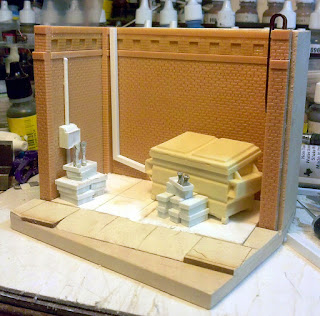
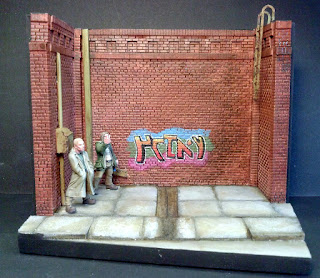 |
The back wall was to blank so I tried my hand at some freehand graffiti. I hid a chunk of this behind the dumpster because I felt like it was dominating the scene to much. Hiding it helped tone it down into a smaller supporting element. |
3) How many minis? Usually the story tells me this. Once I have a story I start to pull minis together that I want to use, often this is a lot more than I need but I'm not sure what I want quite yet. I start adding all the minis to the mockup, its probably pretty crowded at this point. I then start removing minis one at a time. I keep doing this till the story becomes unclear, then I add back that key mini and I know I have all the minis I need to effectively tell the story. That doesn't mean there isn't a place for large dioramas with lots (even hundreds) of miniatures and lots of tiny scenes that add to the whole but time is precious and for a competition I would recommend keeping things as simple as possible.
4) Avoid lines that are parallel to the edges of the diorama/vignette base. Even a small angle will help make your edge look less like an edge. "Steady Lads" is one of the only times I have broken this particular "rule". I felt that by adding in the angles I would actually distract the viewer from the scene and actually lead them right out of it.
 |
| Here you can see how I angled the walls so they weren't parallel to the base. This helps keep the composition flowing from one point to the next and adds a bit of interest. |
5) While a diorama/vignette still needs to be well painted, painting is somewhat secondary to the story. One of the things to remember is that, most of the time, we want the emphasis to be on the miniatures. Background elements should not vie for the viewers attention. Keep colors for secondary elements somewhat muted so that the minis dominate the scene.
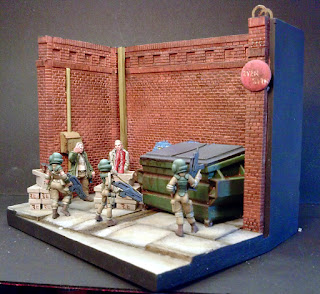 |
| Here we can see how the background elements actually fade into the background and leave the minis as the main elements. |
There you have it, my own personal views on building a successful diorama. There are a number of books that I would recommend as well. I own all of these and they are quite well thumbed through. I have even had to replace my Shep Paine book once.
How to Build Dioramas; Aircraft, Armor, Ship & Figure Models. Shepherd Paine, Kalmbach Publishing
Building Dioramas, Chris Mrosko, Kalmbach Publishing
The Art of the Diorama, Ray Anderson, Kalmbach Publshing (This one might be out of print)
Scenery & Dioramas, Robert Schleicher, Chilton Hobby Series
FAQ; for Constructing and Painting Dioramas, Mario Milla & Rafael Milla, Andrea Press
If you have other good books on dioramas feel free to mention them in the comments.


























